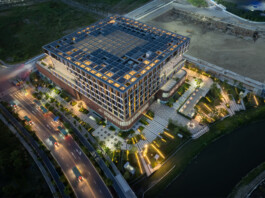WLA AI Lab is Open in Shanghai
July 5, 2024
The newly completed Artificial Intelligence Lab (AI LAB) is located in the core of the World Laureates Association (WLA) Science Community, Lingang New Area.
Developed by Parkland Group, the AI Lab was designed by PLP Architecture, Arup, AISA , alongside a wider team of international design practices: Hassell, ECADI, BAM and HDA. This new workspace was designed to facilitate world-class cutting edge AI research, collaboration and innovation.
Designed for Future AI
The 47,400m2 building is the result of extensive research into the requirements and working practices of the rapidly growing AI sector. Despite the public emergence of AI in recent years, research undertaken by the design team found that most companies in the field operate from generic workspaces originally designed for other purposes. This often leads to fragmented operations, with crucial functions scattered across different buildings or even sites, hindering collaboration and innovation.
The design team conducted extensive research on the spatial requirements for future AI labs, including the typology, scale and functional components. The result is a highly flexible complex space that can respond to the rapidly changing needs of the industry.
Fittingly, the architectural expression of the laboratory building draws upon the most fundamental component of the computer – the Central Processing Unit (CPU). The podium, equivalent to a computer motherboard, houses the Super Lab, Specialist Labs and Data Centre. The Super Lab is a columnless, adaptable, triple-height space, able to host physical simulations of any kind to generate and harvest big data. The Specialist Labs provide flexible space for a range of technological developments. Onsite Data Centres provide a reduction in latency of data transfer vital for AI research and an increase in security.
Putting AI on display
One of the most important components of the project is the Super Lab with a height of 18 metres, a large space that can accommodate complex simulation environments. In a shift from conventional research facilities, the design allows scientists to showcase their work to visitors and the local community, by positioning it facing the Science Boulevard on the north-eastern corner of the podium. This helps to stimulate the public’s interest and participation in science and artificial intelligence.
The podium hosts the main social and collaborative functions of the building. It is divided into four quarters and connected along the north-south and east-west direction through atria. The design aims to create an “urban living room” that enhances the laboratory’s integration into the city. Public areas such as atriums and exhibition galleries will become the best places to display future artificial intelligence development and cutting-edge scientific research results.
Designed for collaboration and innovation
As well as being uniquely suited to the needs of AI research, the AI Lab is designed as a healthy, social and creative place for its occupants. A large, central atrium contains five different collaboration spaces. These enable cross-disciplinary collaboration, to break down the silos commonly found in research facilities and promote spontaneous interactions among researchers.
The General Labs are distributed across four upper floors in the box-shaped tower. Here the space is gathered around a central atrium with staggered volumes form indoor or semi-indoor public spaces into scientific research ecological clusters. Bridges and terraces scattered across all floors—all with the intent of enlivening the atrium, making it a vibrant place for collaboration and exchange. Externally, roof terraces and gardens provide researchers with green, outdoor spaces to relax or recharge.
Sustainability and aesthetics align
The tower’s facade design was influenced by a type of machine learning algorithm where pixels of different configurations are held together within a unifying grid. Stainless steel cladding with a linen finish enables the tower facade to capture natural light at different times of the day and creates a rich visual effect through uneven reflectivity.
The external UHPC fins on the podium facade function as sunshades, carrying out the warm-toned theme, contrasting with the metallic tower cladding. This colour theme also creates a strong connection with the local historic buildings in Shanghai.
The project integrates strategies for energy production and reduced consumption, emphasizing low-carbon, carbon-neutral and life-cycle environmental impact to create a world-class future AI lab with a comfortable, smart, and healthy environment. The project is designed to achieve China Green Star Three, Net Zero Building, LEED Gold and WELL Platinum.
WLA AI Lab is Open in Shanghai
July 5, 2024
The newly completed Artificial Intelligence Lab (AI LAB) is located in the core of the World Laureates Association (WLA) Science Community, Lingang New Area.
Developed by Parkland Group, the AI Lab was designed by PLP Architecture, Arup, AISA , alongside a wider team of international design practices: Hassell, ECADI, BAM and HDA. This new workspace was designed to facilitate world-class cutting edge AI research, collaboration and innovation.
Designed for Future AI
The 47,400m2 building is the result of extensive research into the requirements and working practices of the rapidly growing AI sector. Despite the public emergence of AI in recent years, research undertaken by the design team found that most companies in the field operate from generic workspaces originally designed for other purposes. This often leads to fragmented operations, with crucial functions scattered across different buildings or even sites, hindering collaboration and innovation.
The design team conducted extensive research on the spatial requirements for future AI labs, including the typology, scale and functional components. The result is a highly flexible complex space that can respond to the rapidly changing needs of the industry.
Fittingly, the architectural expression of the laboratory building draws upon the most fundamental component of the computer – the Central Processing Unit (CPU). The podium, equivalent to a computer motherboard, houses the Super Lab, Specialist Labs and Data Centre. The Super Lab is a columnless, adaptable, triple-height space, able to host physical simulations of any kind to generate and harvest big data. The Specialist Labs provide flexible space for a range of technological developments. Onsite Data Centres provide a reduction in latency of data transfer vital for AI research and an increase in security.
Putting AI on display
One of the most important components of the project is the Super Lab with a height of 18 metres, a large space that can accommodate complex simulation environments. In a shift from conventional research facilities, the design allows scientists to showcase their work to visitors and the local community, by positioning it facing the Science Boulevard on the north-eastern corner of the podium. This helps to stimulate the public’s interest and participation in science and artificial intelligence.
The podium hosts the main social and collaborative functions of the building. It is divided into four quarters and connected along the north-south and east-west direction through atria. The design aims to create an “urban living room” that enhances the laboratory’s integration into the city. Public areas such as atriums and exhibition galleries will become the best places to display future artificial intelligence development and cutting-edge scientific research results.
Designed for collaboration and innovation
As well as being uniquely suited to the needs of AI research, the AI Lab is designed as a healthy, social and creative place for its occupants. A large, central atrium contains five different collaboration spaces. These enable cross-disciplinary collaboration, to break down the silos commonly found in research facilities and promote spontaneous interactions among researchers.
The General Labs are distributed across four upper floors in the box-shaped tower. Here the space is gathered around a central atrium with staggered volumes form indoor or semi-indoor public spaces into scientific research ecological clusters. Bridges and terraces scattered across all floors—all with the intent of enlivening the atrium, making it a vibrant place for collaboration and exchange. Externally, roof terraces and gardens provide researchers with green, outdoor spaces to relax or recharge.
Sustainability and aesthetics align
The tower’s facade design was influenced by a type of machine learning algorithm where pixels of different configurations are held together within a unifying grid. Stainless steel cladding with a linen finish enables the tower facade to capture natural light at different times of the day and creates a rich visual effect through uneven reflectivity.
The external UHPC fins on the podium facade function as sunshades, carrying out the warm-toned theme, contrasting with the metallic tower cladding. This colour theme also creates a strong connection with the local historic buildings in Shanghai.
The project integrates strategies for energy production and reduced consumption, emphasizing low-carbon, carbon-neutral and life-cycle environmental impact to create a world-class future AI lab with a comfortable, smart, and healthy environment. The project is designed to achieve China Green Star Three, Net Zero Building, LEED Gold and WELL Platinum.



